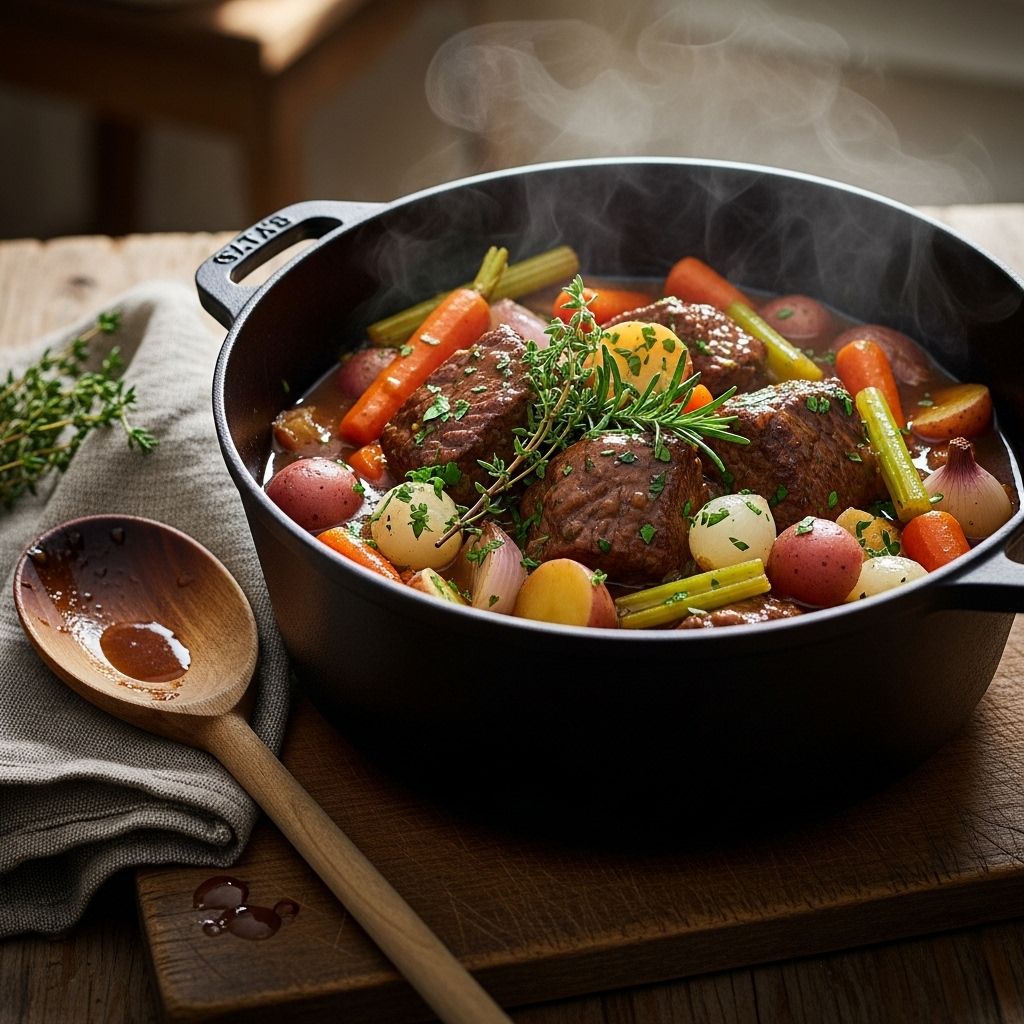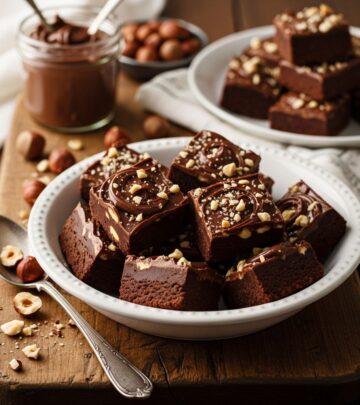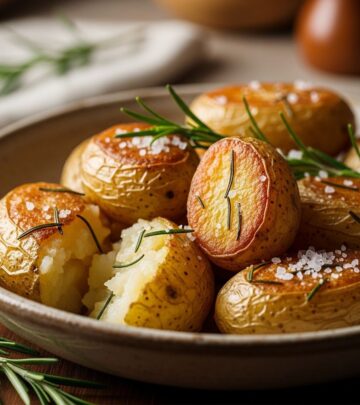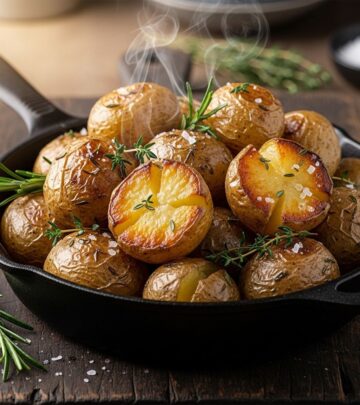Beef Stew Recipe: 6 Essential Steps For Classic Comfort Food
Discover the perfect beef stew recipe that combines tender meat with flavorful vegetables in a rich broth

Image: HearthJunction Design Team
Hearty Homemade Beef Stew: A Classic Comfort Food Recipe
There’s nothing quite like a warm, hearty beef stew to comfort you on a chilly day. This classic beef stew recipe combines tender chunks of beef with perfectly cooked vegetables in a rich, flavorful broth that will satisfy your taste buds and warm your soul. Whether you’re cooking for your family on a weeknight or entertaining guests on the weekend, this foolproof beef stew recipe is guaranteed to impress.
What makes this beef stew special is the perfect balance of flavors and textures. The beef becomes incredibly tender after slow cooking, while the vegetables maintain their integrity without becoming mushy. The savory broth, enhanced with aromatic herbs, ties everything together for a truly memorable meal. Let’s dive into how you can create this classic comfort dish in your own kitchen.
What Makes a Great Beef Stew?
Before we get to the recipe itself, let’s talk about what makes a truly outstanding beef stew. The key elements include:
- Quality beef: The foundation of any good beef stew is, of course, the beef itself. Look for well-marbled stew meat or consider cutting up a chuck roast yourself.
- Proper browning: Taking the time to brown your meat properly creates a depth of flavor that can’t be achieved any other way.
- Balanced vegetables: The classic combination of potatoes, carrots, celery, and onions provides both flavor and substance to the stew.
- Flavorful broth: Building a rich broth with bouillon, herbs, and the natural juices from the meat and vegetables is essential.
- Patience: Great beef stew can’t be rushed. The slow cooking process allows flavors to develop and the meat to become tender.
Now that we understand the fundamentals, let’s gather our ingredients and get cooking!
Ingredients for Perfect Beef Stew
For this classic beef stew recipe that serves approximately 10 people, you’ll need:
For the Meat Base:
- 3 tablespoons vegetable oil
- 2 pounds cubed beef stew meat
- 4 cubes beef bouillon, crumbled
- 4 cups water
Herbs and Seasonings:
- 1 teaspoon dried rosemary
- 1 teaspoon dried parsley
- ½ teaspoon ground black pepper
Fresh Vegetables:
- 3 large potatoes, peeled and cubed
- 4 carrots, cut into 1-inch pieces
- 4 stalks celery, cut into 1-inch pieces
- 1 large onion, chopped
For Thickening:
- 2 teaspoons cornstarch
- 2 teaspoons cold water
This combination of ingredients creates a balanced stew with the perfect ratio of meat to vegetables in a flavorful broth. The cornstarch slurry at the end helps achieve that ideal consistency that clings to your spoon without being too thick.
Step-by-Step Cooking Instructions
Follow these detailed steps to create your perfect beef stew:
Step 1: Browning the Beef
In a large pot or Dutch oven, heat 3 tablespoons of vegetable oil over medium-high heat. Once the oil is hot, add your beef stew meat in batches, being careful not to overcrowd the pan. Brown the meat on all sides until you achieve a rich, caramelized exterior. This process not only seals in the juices but also creates those delicious browned bits on the bottom of the pot that will flavor your broth. This step typically takes about 5-7 minutes per batch.
Step 2: Creating the Broth Base
Once all the beef is browned, dissolve 4 crumbled beef bouillon cubes in 4 cups of water. Pour this mixture into the pot with the beef, making sure to scrape up any browned bits from the bottom of the pot – these contain concentrated flavor! Add 1 teaspoon dried rosemary, 1 teaspoon dried parsley, and ½ teaspoon ground black pepper. Stir well to combine all ingredients and bring the mixture to a boil.
Step 3: Initial Simmer
Once boiling, reduce the heat to low, cover the pot, and let the beef simmer for 1 hour. This initial cooking period allows the beef to start becoming tender and infuses the broth with rich, meaty flavor. The low, slow cooking is crucial for breaking down the tough connective tissues in the stew meat.
Step 4: Adding Vegetables
After the first hour of simmering, add your prepared vegetables: 3 large peeled and cubed potatoes, 4 carrots cut into 1-inch pieces, 4 stalks of celery cut into 1-inch pieces, and 1 large chopped onion. Stir gently to combine everything without breaking up the now-softened beef pieces. The vegetables will release their own flavors into the stew while absorbing the savory broth.
Step 5: Thickening the Stew
In a small bowl, create a slurry by dissolving 2 teaspoons of cornstarch in 2 teaspoons of cold water. Make sure to mix until completely smooth to avoid lumps. Stir this mixture into the stew – it will help thicken the broth to that perfect, silky consistency that clings to the meat and vegetables.
Step 6: Final Cooking
Cover the pot again and continue to simmer until the beef is fork-tender and the vegetables are cooked through but not mushy, about another hour. The total cooking time will be approximately 2 hours, but the actual time may vary depending on the cut of meat and size of your vegetable pieces. The stew is done when the beef easily breaks apart with gentle pressure from a fork.
Tips for the Best Beef Stew
To elevate your beef stew from good to exceptional, consider these professional tips:
Meat Selection and Preparation
- Choose the right cut: Chuck roast, bottom round, or top round work best for stew because they become tender with slow cooking.
- Uniform cutting: Cut meat into uniform 1-inch cubes for even cooking.
- Pat dry: Before browning, pat the meat dry with paper towels to ensure better caramelization.
Vegetable Preparation
- Uniform sizes: Cut vegetables into similar-sized pieces to ensure they cook evenly.
- Potato varieties: Yukon Gold or red potatoes hold their shape better in stews than russet potatoes.
- Add harder vegetables first: If some vegetables cook faster than others, consider adding softer vegetables later in the cooking process.
Flavor Enhancements
- Wine addition: For deeper flavor, deglaze the pan with ½ cup of red wine after browning the meat.
- Fresh herbs: Add a sprig of fresh thyme or a bay leaf during cooking and remove before serving.
- Umami boost: A tablespoon of tomato paste or Worcestershire sauce can add complexity to the broth.
Serving Suggestions
Beef stew is a complete meal on its own, but here are some perfect accompaniments to round out your dinner:
Bread Options
A crusty bread, dinner rolls, or homemade biscuits are perfect for sopping up the flavorful broth. Warm the bread slightly before serving for an extra touch of comfort.
Side Salads
Balance the richness of the stew with a crisp green salad dressed with a light vinaigrette. The acidity will complement the savory flavors of the stew.
Serving Vessels
For an extra special presentation, serve the stew in hollowed-out bread bowls or in pre-warmed, deep soup bowls to keep it hot longer.
Storage and Reheating
One of the best things about beef stew is that it often tastes even better the next day, after the flavors have had time to meld together.
Refrigeration
Cool the stew completely before transferring to airtight containers. It will keep well in the refrigerator for 3-4 days. The flavors will continue to develop overnight, making leftover stew a treat to look forward to.
Freezing
This beef stew freezes exceptionally well. Portion it into freezer-safe containers, leaving about an inch of headspace for expansion. It can be stored in the freezer for up to 3 months. Thaw overnight in the refrigerator before reheating.
Reheating
Gently reheat the stew on the stovetop over medium-low heat, stirring occasionally, until heated through. Add a splash of beef broth or water if needed to achieve the desired consistency. Avoid boiling as this can make the meat tough and the vegetables mushy.
Variations on Classic Beef Stew
While this traditional recipe is delicious as is, here are some variations to consider:
International Twists
- Hungarian style: Add 1-2 tablespoons of paprika and a dollop of sour cream at serving.
- Irish inspired: Replace some of the water with Guinness stout for a rich, malty flavor.
- French Provençal: Add olives, herbes de Provence, and a splash of cognac.
Dietary Adaptations
- Lower carb: Substitute turnips or radishes for potatoes.
- Gluten-free: Ensure your bouillon cubes are gluten-free and use arrowroot powder instead of cornstarch for thickening.
- Extra vegetables: Add mushrooms, bell peppers, or green beans for more vegetable variety and nutrition.
Frequently Asked Questions
Q: Why is my beef stew meat tough?
A: Tough beef in stew is usually the result of insufficient cooking time or cooking at too high a temperature. Stew meat needs low, slow cooking to break down the collagen in the meat, which is what makes it tender. Ensure you’re simmering, not boiling, and give it enough time – sometimes up to 2-3 hours depending on the meat cut.
Q: Can I make beef stew in a slow cooker?
A: Absolutely! Brown the meat as directed, then transfer everything to a slow cooker. Cook on low for 7-8 hours or on high for 4-5 hours. Add the cornstarch slurry during the last 30 minutes of cooking.
Q: How do I thicken my beef stew if it’s too watery?
A: Create another cornstarch slurry with 1 tablespoon cornstarch and 1 tablespoon cold water. Bring the stew to a gentle simmer, add the slurry, and cook for about 10 minutes until thickened. Alternatively, you can remove some of the cooking liquid, blend it with 2-3 tablespoons of flour, and return it to the pot for a more traditional gravy-like consistency.
Q: What can I do if my beef stew is too salty?
A: Add a peeled, quartered potato to the stew and cook for about 15 minutes – the potato will absorb some of the excess salt. Remove before serving. Adding more unsalted vegetables or a bit of acid like lemon juice or vinegar can also help balance the saltiness.
Q: Can I add wine to this beef stew recipe?
A: Yes! Red wine adds wonderful depth of flavor. Add about 1/2 cup after browning the meat, allowing it to simmer for a few minutes to cook off the alcohol before adding the other liquids.
This classic beef stew recipe is more than just a meal – it’s a tradition that brings comfort and satisfaction to any table. By following these detailed instructions and tips, you’ll create a memorable dish that may well become a staple in your cooking repertoire. Enjoy the process of creating this timeless comfort food, and savor every bite of the delicious results!
References
- https://www.allrecipes.com/recipe/25678/beef-stew-vi/
- https://www.allrecipes.com/recipe/14685/slow-cooker-beef-stew-i/
- https://www.allrecipes.com/recipe/279251/simple-beef-stew/
- https://www.pinterest.com/pin/beef-stew-vi–1970393574483457/
- https://www.allrecipes.com/recipe/25200/slow-cooker-beef-stew-iv/
Read full bio of medha deb












